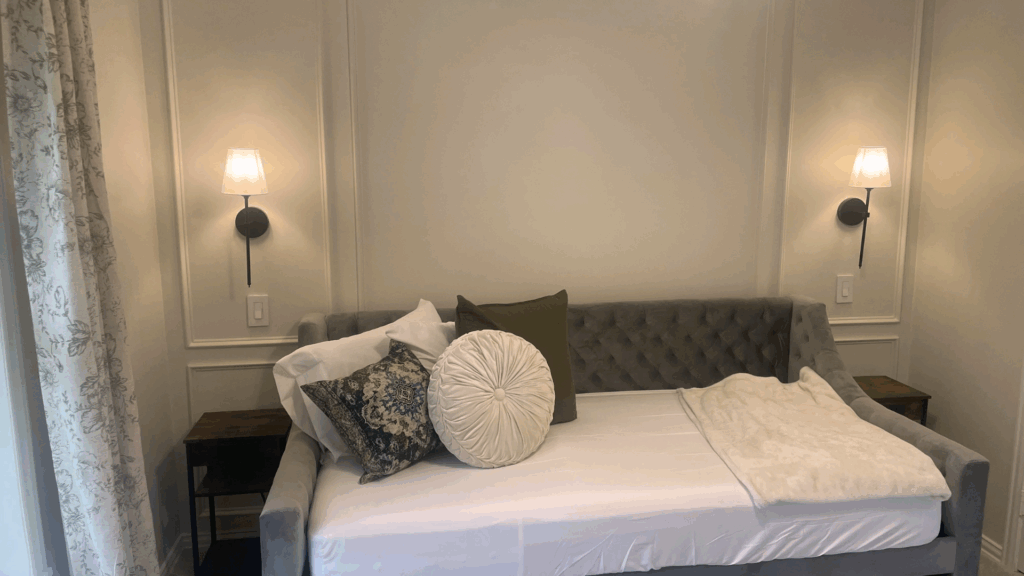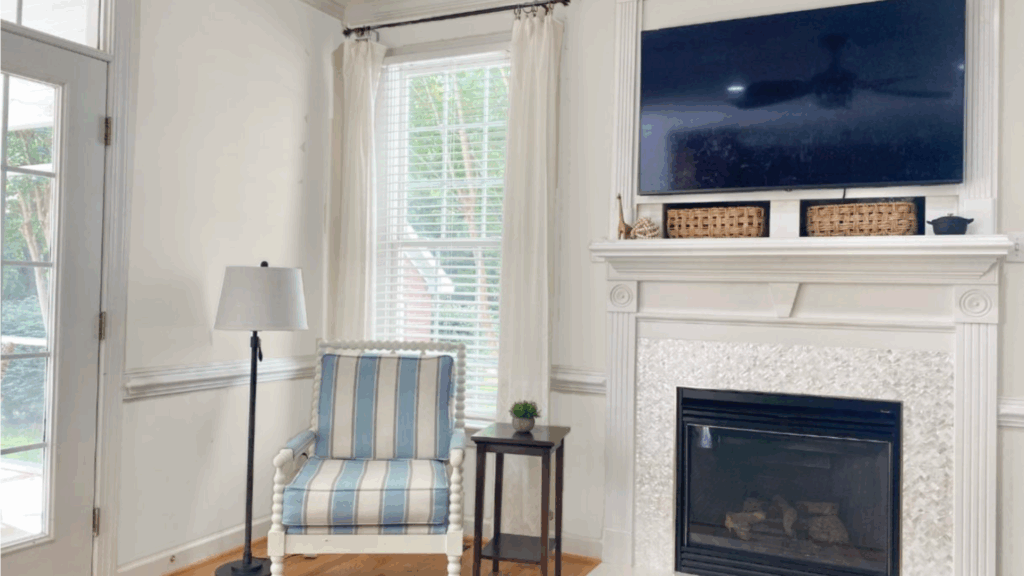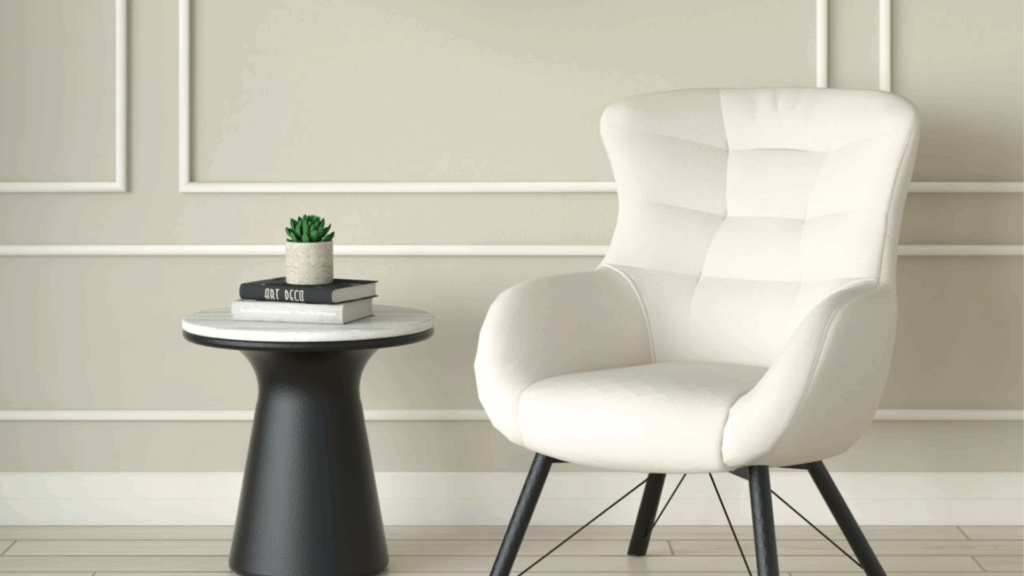White paint is always a go-to choice. It feels clean, bright, and easy to match. But sometimes, plain white can feel too cold or flat.
That’s why many people want something with a little more warmth, without losing that fresh look.
I used it in my own home office, and it made the room feel brighter without that harsh, sterile look. It paired nicely with wood shelves and black hardware.
In this post, you’ll find:
- Its undertones and key features
- Tips for buying and testing it
- How it compares to other popular Sherwin-Williams whites
Sherwin-Williams’ Pearly White offers that balance. It’s a soft, warm white that’s been getting attention for how calm and cozy it looks in real homes. Let’s get started!
The Deep Undertones that Make Pearly White Stand Out
Pearly White (SW 7009) is not your typical plain white. It has warm greige and beige undertones, with just a touch of yellow that keeps it from feeling cold. This mix makes it feel soft and lived-in, which is why it’s becoming so popular.
Its LRV is 77, meaning it reflects a good amount of light but still has depth.
I noticed that in natural daylight, it leaned a little cooler, almost like a soft off-white. But once the sun started going down and the warm lights came on, it felt cozier and warmer.
That’s what I like most about it. It doesn’t feel dull, but it doesn’t feel too bright either.
If your room gets a lot of natural light or has soft, warm bulbs, Pearly White really shows its best side. I used it in a bedroom with big east-facing windows.
In the morning, it looked clean and fresh. By evening, it felt calm and warm, without ever turning yellow or muddy.
It’s a flexible shade that works if you want something more interesting than flat white but still want to keep things light. Try it on a sample board and watch how it shifts through the day.
Key Features and Attributes of Pearly White

Pearly White is a soft white that brings a calm and lived-in feel to a space. It’s not too bright or too beige, it sits right in the middle. This is what you should know if you’re thinking about using it in your home.
1. Finish Options
Pearly White is available in multiple finishes like flat, eggshell, satin, semi-gloss, and gloss. I’ve used it in satin on kitchen cabinets and eggshell on bedroom walls, and both turned out great.
Satin has a soft sheen and is easy to clean, which makes it a smart choice for higher-traffic areas.
Eggshell works well for general wall use; it’s not shiny but still holds up to occasional cleaning. You can pick the finish that suits how the space is used.
2. How It Feels in a Room
To me, Pearly White feels soft, clean, and warm without going too yellow or dull. It’s one of those colors that settles into the background but still adds something.
It doesn’t fight for attention, and that’s what makes it useful in a lot of spots. I’ve seen it used in family rooms, bedrooms, and even bathrooms. It helps create a neutral base that doesn’t feel cold.
It works whether you want to keep things light and simple or build layers with color and texture.
3. What It Pairs Well With
This paint plays nicely with other design elements. It works well with light and dark wood tones, brass or black metal finishes, and even soft pastels.
I paired it with medium oak floors and matte black door handles, and it looked great.
You can also bring in soft blues or muted greens if you want some color around it. Since it’s a warm white, it complements earthy colors better than cooler whites do.
4. Where to Use It
Pearly White is flexible enough for many surfaces. You can use it on walls, trim, cabinets, or even ceilings.
I’ve used it on kitchen cabinets with a satin finish, and it wipes clean easily. For trim, I prefer semi-gloss, and for walls, eggshell works well.
It also looks good in open-concept spaces where you want one color to flow from room to room. If you’re not sure where to start, try it on a wall and see how it feels in different lighting before committing to a full project.
Ordering and Sampling of Pearly White by Sherwin-Williams
Before you commit to painting a whole room, it’s smart to test Pearly White in your space. I’ve seen it look different from room to room, even in the same house.
The way it reads depends on lighting, wall direction, and even time of day. That’s why I always recommend trying a sample first.
You can get samples at any Sherwin-Williams store. They also offer online ordering for small paint testers if you’d rather have it shipped. Another easy option is peel-and-stick swatches.
I’ve used those, and they’re mess-free and quick to move around the room. Pearly White comes in several sheens.
I usually go with eggshell for walls and satin or semi-gloss for trim or cabinets. If you’re not sure how much paint to buy, Sherwin-Williams has a paint calculator tool on their website.
It’s easy to use; you just plug in your room size, and it gives you an estimate. That helped me avoid overbuying more than once.
Testing and planning ahead can save you time and effort. A little prep really does make the whole project smoother.
Application Tips for a Flawless Pearly White Finish
Getting a clean, even finish with Pearly White isn’t hard, but a few simple steps can make a big difference. I’ve painted with this shade a few times, and this is what worked best for me.
1. Use the Right Primer
If you’re covering a dark or bold color, always start with a good primer. I recommend a white or light gray stain-blocking primer. It helps the color stay true and cuts down on how many coats you need.
I skipped primer once, and the old color bled through; don’t make that mistake.
2. Choose the Right Tools
For smooth walls, I’ve had good results with a 3/8-inch nap roller. It gives a nice, even coat without leaving texture.
For trim or edges, use a quality angled brush. Cheap brushes can leave streaks, and that shows more with light colors like Pearly White.
3. Plan for Two Coats
Even with a primer, it always needed two coats for full coverage. The first coat might look patchy, but there’s no need to panic. Let it dry fully before adding the second. That’s when the color really evens out.
4. Watch the Lighting
One big mistake is painting in poor lighting. Always make sure to paint during the day or use bright white bulbs.
Otherwise, you will miss spots or not notice uneven areas until later. Good lighting helps you see what’s really going on with the color.
Durability and Longevity of Pearly White

Thinking of using Pearly White outdoors? It can work beautifully with the right prep and finish.
- Great for trim, doors, or shaded siding areas
- Use satin or semi-gloss for durability and easy cleaning
- Prime surfaces well and choose high-quality exterior paint
- May fade slightly faster in full sun – check for touch-ups
- Satin gives a soft look; semi-gloss adds toughness and shine
Pearly White vs. Other Sherwin-Williams Colors?
Choosing between Pearly White and other Sherwin-Williams whites? I’ve tried them all, and each has its own look. Here’s a simple comparison to help you choose what fits best.
| Color | Undertone | Feels Like | Best Used When… |
|---|---|---|---|
| Pearly White | Greige with a hint of yellow | Soft and warm, not stark | You want a balanced, cozy white that stays flexible |
| Alabaster | Warm beige | Creamier and richer | You want warmth and depth, especially in traditional spaces |
| Pure White | Cool, very slight gray | Clean and crisp | You want a more modern, neutral white with no warmth |
| Greek Villa | Warm with yellow tones | Brighter and slightly golden | You want a sun-kissed white for bright, classic rooms |
Each one works well in the right setting. I’d pick Pearly White when I want softness without going too creamy.
Conclusion
Pearly White (SW 7009) is a reliable and flexible white that brings just the right amount of warmth without feeling too yellow or too bright. I’ve found it works in lots of spaces, walls, trim, and even cabinets.
You can pair it with wood, black, or brass, and it fits in with both modern and classic styles.
Still, I always suggest you test it in your space first. Try a sample on different walls and look at it during the day and at night. Lighting makes a big difference.
If you’re unsure, start with a trim or a smaller room. That’s how I got comfortable with it before using it in more places. Have you used Pearly White in your home?
I’d love to hear how it turned out. Drop a comment or ask a question, I’m happy to help.

